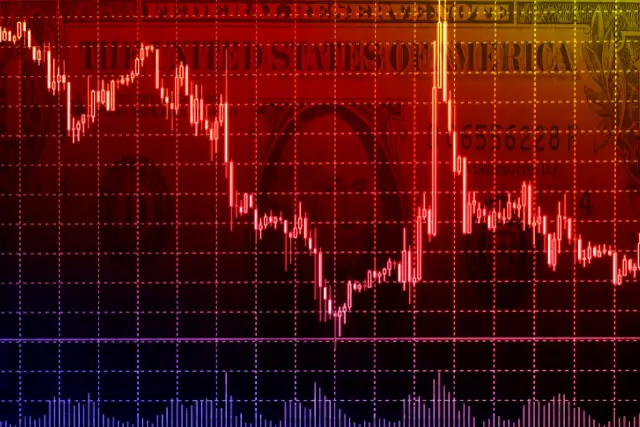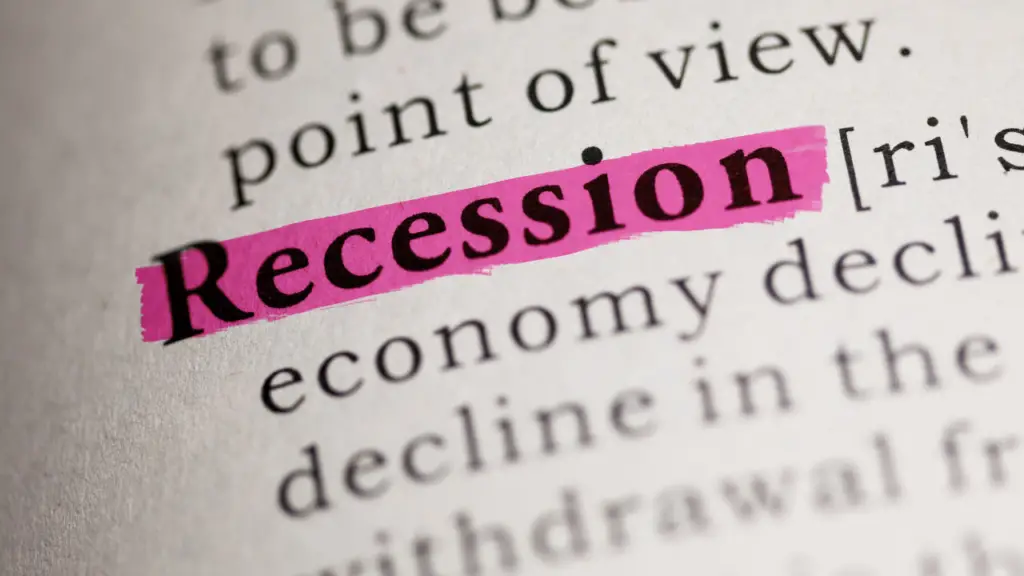Many economic terms are seen in the news and discussed by financial experts. It can be difficult to know the real difference between them all. In this blog post, we help explain the terms correction, recession, and depression in detail and compare their main differences.
By the end of this post, you will better understand these terms and know how to apply them to your own life and finances.
This post may contain affiliate links; please see our disclaimer for details.

Table of Contents
What Is a Correction?
A correction in economic terms is a reversal of a previous move in price, interest rates, or exchange rates.
A correction is usually temporary with prices typically returning to their original levels after the correction has occurred.
For these reasons, a correction is different than a recession or depression.
There are three main types of corrections:
- Price Corrections
- Interest Rate Corrections
- Exchange Rate Corrections
Price corrections
This is the most common type of correction and occurs when there is a sudden change in price levels. Price corrections occur due to changes in demand or supply, news events, or even rumors.
Price corrections usually last for a short period, and prices will eventually return to their original level.
However, the reason for the price change could be something more serious. Such as a change in the underlying fundamentals of the economy. In this case, the price correction could last for a longer time.
The stock market is a common place to find price corrections.
For example, a price correction happens when a company announces bad news and its stock price falls sharply. It could also happen when there is an overvaluation of stock, and investors suddenly realize this and start selling.
Interest rate corrections
When rates are low for an extended period and then begin to rise. The result is higher mortgage payments for borrowers. Thus leading to many who end up defaulting on their loans.
Lenders may also suffer losses when they have to resell properties going into foreclosure.
While interest rate corrections can be painful for those involved, they are a necessary part of the economic cycle. Central banks use interest rates to manage inflation and keep the economy growing.
Rates dipping too low can lead to inflationary pressures. Raising rates helps to cool the economy and prevent inflation from spiraling out of control.
Eventually, rates will begin to rise again, and the cycle will repeat itself. Remember, interest rate corrections are a normal part of the economic cycle and happen from time to time.
While they may be painful in the short term, borrowers and lenders should remember that interest rate corrections are necessary. They help keep the economy healthy in the long run.
Exchange rate corrections
These types of corrections are usually nothing to fear. A country’s exchange rate is like the price of its currency on the global market. The laws of supply and demand influence exchange rate corrections.
When a country’s currency becomes more valuable, its exports become more expensive for other countries to buy. As a result, the demand for that country’s currency decreases, and its value decreases.
The opposite happens when a currency becomes less valuable.
Exchange rates are always changing, and corrections are a normal part of that process. A correction occurs when a currency’s value suddenly drops or rises sharply.
Various factors cause these corrections, including political instability, natural disasters, or changes in interest rates.
It can be financially dangerous if a currency starts entering hyperinflation. It may lose so much value at this point that it becomes worthless. A currency crisis can also cause a country’s economy to collapse.
For these reasons, monitoring a country’s exchange rate is important if you are planning to do business there. However, it is also important to not be fearful and to know that corrections are normal.
When investing in a country with a volatile exchange rate, it’s important to conduct research and understand any risks. Make sure to diversify your investments to protect yourself from sudden changes in the value of a currency.
Several factors go into play with corrections, but they typically involve some sudden change. Although corrections are usually temporary, they can sometimes last for a longer time, depending on the seriousness of the underlying cause.
Keep an eye on corrections to keep your investment portfolio safe.
As a recap, remember that corrections are normal and a part of the economic cycle.
What is a Recession?

A recession is different than a correction because it is a significant decline in economic activity spread across the economy. The length of time for a recession is more than a few months.
You can see signs of a recession in industrial production, employment, real income, and other indicators.
A recession begins when the economy reaches a peak of activity and ends when it reaches its trough. Between a peak and a trough, there is a period of contraction or decrease in economic activity.
To simplify, we can think of a recession as two consecutive quarters of a decline in real GDP.
The National Bureau of Economic Research (NBER) Business Cycle Dating Committee declares a recession in the United States.
They don’t rely on GDP data alone but also look at other indicators like employment data.
Three features generally characterize recessions:
- A significant decline in economic activity. This can be measured by GDP, employment, personal income, etc.
- Duration of more than a few months. Generally, recessions last between six and eighteen months.
- A widespread decline across the economy. A recession confined to one sector or region is not generally considered a recession.
A recession is often accompanied by a drop in the stock market and higher unemployment. But it’s important to remember that a recession is not the same as a depression.
What Is a Depression?
Unlike a correction or recession, a depression is a more severe economic downturn, lasting longer and with more widespread effects. Social and political unrest can increase during depression as people lose faith in their government’s ability to improve their situation.
Depression-era literature often reflects this sense of hopelessness and despair. The Great Depression was the most significant economic downturn in modern history, lasting from 1929 to 1939.
It led to widespread unemployment, poverty, and social upheaval across the globe. The Great Depression also impacted the arts, with many artists exploring themes of despair and hardship in their work.
While the effects of a depression can be severe, it is important to remember that economies and societies always eventually recover from them. The Great Depression eventually led to a much more prosperous post-World War II era.
So, while a depression can be a tough time, it is important to remember that things will eventually get better.
What Are The Main Differences?
The main differences between a correction, a recession, and a depression are the following:
Time Period:
- A correction is a short-term stock market decline lasting no more than a few months.
- A recession is a significant decline in economic activity spread across the economy, lasting more than a few months.
- A depression is a more severe economic downturn, lasting longer and with more widespread effects.
Causation:
- A correction is often caused by a temporary imbalance in the market.
- A recession is generally caused by a combination of factors, including tight monetary policy, high-interest rates, and declining consumer confidence.
- A depression is generally caused by a major shock to the economy, such as a financial crisis or a major natural disaster.
How To Solve:
- Market forces can help to solve corrections.
- A recession may require government intervention.
- Depressions often require both government intervention and major structural changes to the economy.
Short-Term Effects:
- Corrections often lead to a decline in the stock market.
- Recessions can lead to a decline in economic activity.
- Depressions lead to a decline in both the stock market and economic activity.
Next Economic Period:
- Both corrections and recessions are often followed by a period of growth.
- Depressions can often be followed by a period of stagnation or decline.
As you can see, there are some major differences between a correction, a recession, and a depression. However, it is important to remember that all three terms refer to a decline in economic activity.
So, if you are experiencing a decline in your economic activity, it is important to seek help and take action to improve your situation.
Conclusion: Correction vs. Recession vs. Depression
Understanding these three different terms correction, recession, and depression can help you better understand the current state of the economy and what you can expect in the future.
If you are wondering whether we are in a correction, a recession, or a depression, do your research and stay informed. Thanks for reading!
Disclaimer:
We hope the information in this article provides valuable insights to every reader but we, the Biesingers, are not financial advisors. When making your personal finance decisions, research multiple sources and/or receive advice from a licensed professional. As always, we wish you the best in your pursuit of financial independence!

